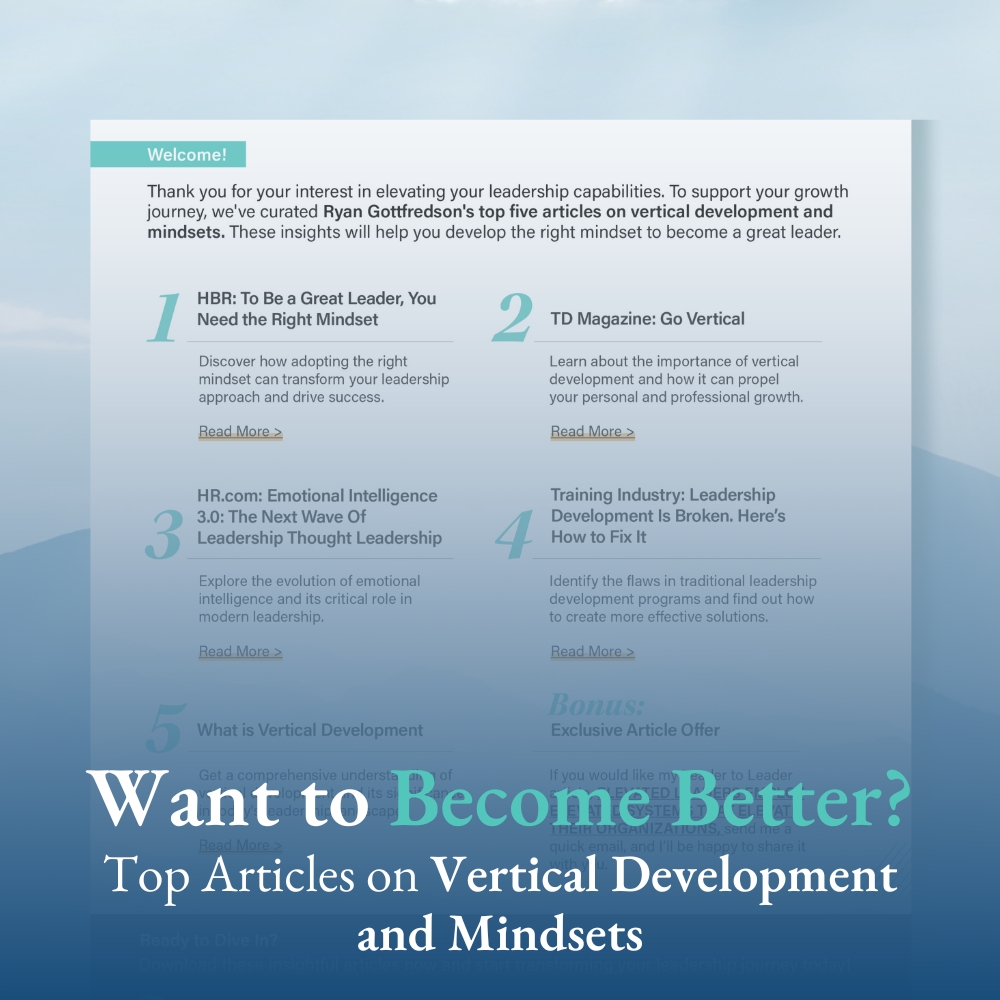There are three modern business leaders that I have studied that:
- Are great examples of being Mind 3.0 (i.e., highly vertically developed) leaders that…
- Have actualized transformational change in the organizations they led.
These leaders are:
- Alan Mulally (Ford) – see American Icon
- Ed Catmull (Disney Animation) – see Creativity, Inc.
- Satya Nadella (Microsoft) – See Hit Refresh
All three of these leaders took their organizations from deeply in the dumps to wildly successful.
- Mulally took Ford from an annual loss of $17 billion to being on of the most respected brands in the United States.
- Catmull resuscitated Disney Animation from being stale to breaking box office records.
- Nadella has led a 10x growth in market cap and stock price in the 10 years he has been CEO.
As I have studied these three leaders, I have asked myself two primary questions:
- What is it about them, as opposed to other leaders, that has allowed them to actualize transformational change in their organization?
- What have they done that has been pivotal in the process of actualizing the transformational change?
I will take on each question in turn.
What Makes Transformational Change-Makers Unique?
A simple, but deep, answer to this question is: They are all vertically developed.
They all operate with a Mind 3.0 operating system. This means a few different things:
1. Vertically Developed Leaders are Programmed to Contribute, Add Value, & Lift Others
Developmental psychologists have found that everyone possesses an internal operating system (i.e., their body’s sensemaking system that involves their mind, nervous system, stress response system, goal regulation system, and perceptions) that is programmed to obtain different needs.
- Mind 1.0 internal operating systems are programmed to help the individual feel safe, comfortable, and like they belong.
- Mind 2.0 internal operating systems are programmed to help the individual standout, advance, and get ahead.
- Mind 3.0 internal operating systems are programmed to help the individual contribute, add value, and lift others.
Developmental psychologists have also found that most adults operate with a Mind 1.0 internal operating system, while most executives operate with a Mind 2.0 internal operating system:

Transformational change-makers possess a Mind 3.0 internal operating system. They are willing to put their Mind 1.0 needs of safety, comfort, and belonging on the back burner in order to contribute, add value, and lift others. They are also willing to put their Mind 2.0 needs of standing out, advancing, and getting ahead in order to contribute, add value, and lift others.
A key differentiator of those with a Mind 3.0 internal operating system is that they are outward-focused, while those with Mind 1.0 or Mind 2.0 internal operating systems are inward-focused.
If you want to watch a great video clip to give you a sense of the quality of your operating system, watch this: Locating Yourself – A Key to Conscious Leadership.
Mulally, Catmull, and Nadella all have internal operating systems that are less focused on their internal self-protection or self-advancement, and more focused on external contribution.
2. Vertically Developed Leaders Have a Wide Window of Tolerance
Vertically developed leaders are centered and balanced. It is really difficult to throw them out of whack. It is not easy for them to become self-protective or defensive.
Mind 1.0 and Mind 2.0 leaders have narrow windows of tolerance for things like failure, being wrong, having problems, and getting passed up. This is because all of these things but their Mind 1.0 and Mind 2.0 needs in danger.
Mind 3.0 leaders have wide windows of tolerance for things like failure, being wrong, having problems, and getting passed up. In fact, they often see these things as evidence that they are contributing, lifting, and elevating. Specifically:
- When something fails, they seek to learn from it.
- They aren’t ashamed to admit when they are wrong.
- They anticipate problems as they continue to push the envelope.
- They care more about others’ successes than their own successes.
Since having a wide window of tolerance for these things is rare, this is a reason why we see so few people with a Mind 3.0 internal operating system.
If you read the three books identified at the top of this article, you will see ample evidence of Mulally’s, Nadella’s, and Catmull’s centeredness and balance. Let me highlight a few:
- Mulally: Encouraged executives and leaders to be transparent about their failings and problems so that they could quickly address them.
- Catmull: Created braintrust meetings to critically analyze the progress of their films in a safe and productive manner.
- Nadella: Supported leaders when things didn’t go as planned. He recognized that problems happen when you are being innovative, and he encouraged them to keep pushing when they did occur.
3. Vertically Developed Leaders are Infinite-Minded
Leaders who are finite-minded are focused on winning in the short term. They are performance-centered and primarily concerned about hitting the goals or metrics expected of them. They are the type of leaders who hold really tightly to hitting quarterly and/or annual shareholder expectations. This does not describe Mulally, Catmull, or Nadella.
Infinite-minded leaders are focused on continual and future success. They are purpose-centered and primarily concerned about adding value to all their stakeholders. They are the type of leaders who don’t get hung up on short-term expectations, but are deeply devoted to long-term growth and success.
Here are some examples:
- Mulally: Was willing to take a multi-billion-dollar hit to Ford’s bottom line to convert their truck from a steel frame to an aluminum frame because he believed it positioned them to be more successful in the future.
- Catmull: Didn’t let Steve Jobs (the principal funder of Pixar) into braintrust meetings because he felt it would be disruptive to the group’s safety and creativeness.
- Nadella: Changed Microsoft’s approach of trying to produce what they think their customers would need or want to asking their customers what they need or want and then creating that for them. This was the impetus for being less Windows- and Office-centric and more cloud-first.
Now, on to the second question.
What Do These Leaders Do to Actualize Transformational Change?
Of course, Mulally, Catmull, and Nadella did 1,000s of things that led to successful transformation. But, in my observation, there are four foundational things that they did, upon which all other actions and decisions rested upon. Stated differently, these four things became filters that they used to pass any decision making through.
Before I identify these four things, I want to make two observations, one that feels more like good news and the other that feels more like a challenge:
- These things are all replicable (which is the good news)
- The success of the implementation of these three things hinges upon the leader’s vertical altitude (which is the challenge). The higher the leader’s vertical altitude the more they will be able to leverage the power of these three things.

1. Mind 3.0 leaders develop an inspirational, clear, and stakeholder-centric purpose
What I have observed is that:
- Mind 1.0 leaders generally don’t develop a purpose, but their focus is on doing what is most easy or comfortable.
- Whether Mind 2.0 leaders have a formalized purpose or not, their purpose is generally focused on hitting certain performance outcomes.
- Mind 3.0 leaders invest in developing an inspirational, clear, and stakeholder-centric purpose.
Observe how the three leaders developed a purpose for their organization:
Mulally – Knowing the storied history of Ford, Mulally looked to Ford’s past for inspiration. He found an advertisement from 1925 that read:
Opening the Highways to all Mankind
An organization, to render any service so widely useful, must be large in scope as well as great in purpose. To conquer the high cost of motoring and to stabilize the factors of production—this is a great purpose.
For Mulally, this became Ford’s northstar: “Opening the highways to all mankind.” 1,000s of decisions were passed by this purpose: Does this allow us to better open the highways to all mankind?
In my personal communication with Alan, he told me that a big part of this purpose included: A focus on creating long-term value and profitable growth for all of Ford’s stakeholders (e.g., customers, dealers, employees, suppliers, community, etc.)
Catmull – In his book, Creativity Inc., Catmull states: “While there was much innovation that enabled our work, we had not let the technology overwhelm our real purpose: Making a great film.” Everything gets filtered through this purpose: Does this allow us or help us to make a great film? In support of this, he also states: “We realized that our purpose was not merely to build a studio that made hit films but to foster a creative culture that would continually ask questions.”
Nadella – After becoming CEO of Microsoft, already had an inkling of a renewed purpose of Microsoft. In his first email to the organization, he stated:
Qi Lu captured it well in a recent meeting when he said that Microsoft uniquely empowers people to “do more.” This doesn’t mean that we need to do more things, but that the work we do empowers the world to do more of what they care about — get stuff done, have fun, communicate and accomplish great things. This is the core of who we are, and driving this core value in all that we do — be it the cloud or device experiences — is why we are here.
Nadella then spent the next year listening to employees. He said it was the most important thing that he could do. All of this listening was in an effort to develop a clear purpose statement, which resulted in: “To empower every person and every organization on the planet to achieve more.”
And then, every decision the company made was filtered through this purpose: Does this help ___________________ achieve more?
2. Mind 3.0 Leaders Develop a Clear Set of Values & Lovingly Hold Their Leaders Accountable to Them
A purpose statement identifies what an organization does, with a “why” behind it. But, a clear set of values defines how they are going to do it.
For Mulally, he developed 11 values:
- People first…Love ‘em up
- Everyone is included
- Compelling vision, comprehensive strategy, and relentless implementation
- Clear performance goals
- One plan
- Facts and data
- Everyone knows the plan, the status, and areas that need special attention
- Propose a plan, positive, “find-a-way” attitude
- Respect, listen, help, and appreciate each other
- Emotional resilience – trust the process
- Have fun – enjoy the journey and each other
For Catmull, if you read Creativity, Inc., it is clear that Catmull instilled values that fuel creativity:
- Honesty
- Candor
- Embracing failure
- Remedy any psychological fears
- Conflict is healthy
- Change is our friend
- Embrace randomness
- Uncover what is unseen
For Nadella, one of his biggest priorities when taking over as CEO was the culture of Microsoft. In fact, he said that the “C” in CEO stands for “Curator of Culture.” To elevate Microsoft’s culture, Nadella invested in the development of growth mindsets. Specifically, he:
- Put together a growth mindset team, focused on promoting the value of a growth mindset around the organization
- Did a monthly webinar where he talked about the things that he had been learning
- Encouraged employees to learn about a growth mindset
- Had employee tags updated to include the saying: “From ‘know-it-all’ to ‘learn-it-all’”
- Encouraged teams to ask, “Was this a growth or a fixed mindset meeting?” after every meeting.
Not only did these leaders use these values to help guide decision making, but they also were relentless in ensuring employees, particularly their executive teams, lived up to these values. They didn’t cut any slack for “top performers” because they were “top performers.” They were either “on board” with these values or they were making the decision to work elsewhere.
3. Mind 3.0 Leaders Create Psychologically Safe Space for their Leadership Team
Something unique about each of these leaders is that they all developed a regular cadence of meetings with the organizations’ leaders. They all saw these meetings as among the most important things that they did.
For these meetings to work, all three leaders understood that in order for them to be productive, there needed to be a sense of psychological safety. They wanted transparent candor to be in the room. It needed to be a space where they could admit failures or problems, so they could get one with resolving them as quickly as possible with as much help as possible. They knew that, prior to their leadership, such dialogue was generally happening at the water cooler, but not in the actual meeting.

Perhaps unsurprisingly, the openness that these leaders wanted did not immediately occur. In each instance, the people in the meetings were quite protective, and it took each leader significant time and effort to earn their team’s trust and develop a psychologically safe space for them to have hard but necessary discussions involved in transformation. But, each leader knew the long-term value of establishing this shared trust.
Mulally had a weekly Business Plan Review meeting where executives provided a signal of “red light” (off plan and still stuck), “yellow light” (off plan, but getting back on plan), or “green light” (on plan) to quickly identify progress being made and where issues were.
For the first couple of months, all of Ford’s executives gave “green lights,” despite the fact that they were set to lose billions that year. It wasn’t until one executive gave a “red light” and retained his job that other executives felt safe to give “red lights.” In fact, Mulally says that the executive giving a “red light” was “One of the most important moments in the turnaround of Ford.”
For more on this, read this article: https://www.markerbench.com/blog/2013/02/21/Mulally-leadership/
Catmull instituted a meeting called Braintrust. Catmull writes that “Its premise is simple: Put smart, passionate people in a room together, charge them with identifying and solving problems, and encourage them to be candid with one another.” The key to the Braintrust’s success is candor, or forthrightness and frankness. In order for candor to be present, psychological safety must abound. In fact, to help ensure this psychological safety was present, Catmull did not allow Steve Jobs to attend many Braintrust meetings. Catmull says that these Braintrust meetings are a critical element of fulfilling their purpose of making great films.
For more on this, read this article: https://www.fastcompany.com/3027135/inside-the-pixar-braintrust
Nadella relies upon a weekly SLT (senior leadership team) meeting. He calls it “one of the most important meetings” that he leads.
Just after becoming CEO, he took the SLT to an open-air part of Microsoft’s campus to work with a performance psychologist. The psychologist asked them if they were interested in having an “extraordinary individual experience.” They all nodded yes. But, then he asked for a volunteer to stand up. No one did. It was a quiet and awkward moment. The psychologist asked: “Why wouldn’t everyone jump up? Wasn’t this a high-performing group? Didn’t everyone just say they wanted to do something extraordinary.”
Commenting on this moment, Nadella writes: “The answers were hard to pull out, even though they were just beneath the surface. Fear: of being ridiculed; of failing; of not looking like the smartest person in the room. And arrogance: I am too important for these games. ‘What a stupid question,’ we had grown used to hearing.”
Eventually, the psychologist got them to open up, leading Nadella to write: “As I listened, I realized that in all of my years at Microsoft this was the first time I’d heard my colleagues talk about themselves, not exclusively about business matters. Looking around…, I even saw a few teary eyes.”
4. Lead the Creation of a Comprehensive Strategy and Relentless Implementation Plan to Deliver on the Compelling Purpose
There will never be one strategy that will work with all organizations. Yet, for every organization, there is at least one strategy that puts them on the path of transformational and sustainable change.
But, the only way for a transformational and sustainable change strategy to be developed and successfully implemented is if the leadership first lays the foundation of:
- An inspirational, clear, and stakeholder-centric purpose and clear values to guide thinking and decision making
- A psychologically safe environment for effective discussion and strategizing to occur.
As you might expect, Ford’s, Microsoft’s, and Disney Animation Studio’s strategies were all different, but let me provide a high-level overview of key elements of their strategies and then make an important observation.
Mulally’s strategy involved the following:
- Operate as a global enterprise (instead of a conglomeration of regional enterprises)
- Invest in the Ford and Lincoln brands and reduce the focus on the other brands (e.g., Jaguar, Land Rover, Mazda, Volvo)
- Aggressively restructure production to closely match demand
- Accelerate development of new products that customers want and value
- Ensure financing for the fulfillment of the strategy
Catmull. After Disney bought out Pixar and put Ed Catmull at the head of Disney Animation Studios, Catmull’s strategy was focused on creating a sustainable creative environment. To do that, Catmull:
- Prioritized ensuring that “every Disney Animation employee should feel free to talk to any colleague, regardless of position, and not be afraid of repercussions”
- Sought to remove any sense of alienation and fear
- Encouraged personality, color, and creativity in the office space
- Remodeling the office building to enhance collaboration capabilities
- Improve the feedback system
- Empowered employees to come up with solutions
Nadella. There are four main areas that Nadella focused on shortly after becoming CEO:
- He invested in improving Microsoft’s culture. He said that the “C” in CEO stands for “Curator of Culture.” To improve Microsoft’s culture, he focused on helping employees develop more positive mindsets (e.g., growth).
- He opened the doors for collaboration with competitors. This was a 180-degree shift from Ballmer. Nadella recognized that if their program could be integrated with their competitor’s products, they could rapidly expand their customer base.
- Under Ballmer, Microsoft focused on creating products that they thought their customers might need or want. They had some hits, but they had a lot of misses. Instead of engaging in this guesswork, Nadella had Microsoft employees simply ask their customers what they wanted and then focused on creating those.
- He knew that they needed to be a leader in cloud computing, and saw that as their biggest opportunity to add value to their customers, grow, and be at a competitive advantage.
In instituting these strategies (fueled by purpose, values and psychological safety), Mulally, Catmull, and Nadella did something that is the most difficult part of transforming an organization: they got the existing leaders and employees to let go of old ways of thinking and operating and helped them embrace new ways of thinking and operating.
Summary
Actualizing transformational change requires:
- Vertically developed leaders with wide windows of tolerance who are infinite-minded
Who then prioritize four necessary ingredients for transformational change:
- Developing a clear, inspirational, and stakeholder-centric purpose
- Developing clear values
- Developing psychological safety
- With these three elements in place: the creation of a comprehensive strategy and relentless implementation plan to deliver on the clear, inspirational, and stakeholder-centric purpose
While these things seem pretty basic, Mind 1.0 and Mind 2.0 leaders rarely, if ever, prioritize these things.
But, they are replicable.
Although, without a Mind 3.0 leader, how they are executed will likely be different than what we saw with Mulally, Catmull, and Nadella. It is likely that in the execution of these things, a Mind 1.0 leader will focus on ease and comfort, and a Mind 2.0 leader will focus on performance outcomes. And, in so doing, their ability to be transformational will be limited.
Thus, these things are not boxes to be checked off. If leaders want to actualize transformation, they need to, in this order:
- Vertically develop.
- Institute vertically developed practices like developing a clear purpose, developing clear values, and creating a psychologically safe environment for their leadership team.
Good News: We Can Help Leaders Vertically Develop
The first prerequisite for transformational and sustainable growth is to have a leader that operates with a Mind 3.0 internal operating system.
While it is unfortunate such leaders are rare, the great news is that we can help leaders vertically develop. There is rigorous science stemming from both psychology and neuroscience that informs how we can do this.
When I work with executive and leadership teams, I create two tracks of development:
- I help leaders individually vertically develop (workshops, self-assessments, coaching, 360s)
- I help the leadership team do what vertically developed leaders naturally do: develop a clear purpose and clear values and create a psychologically safe space and comprehensive strategy
If you want to assistance with one or both of these tracks, I would love to help you.









